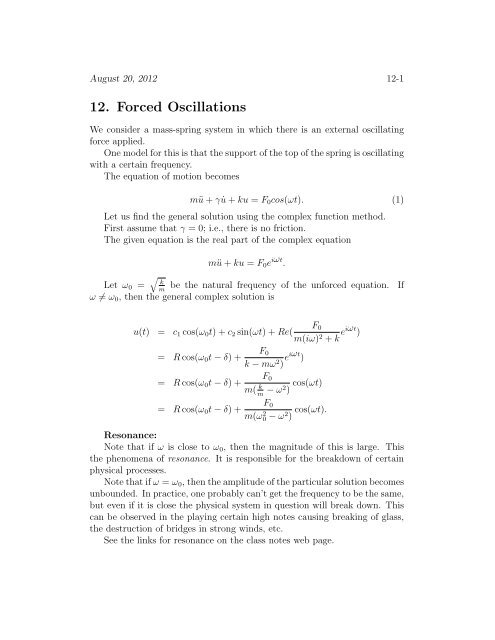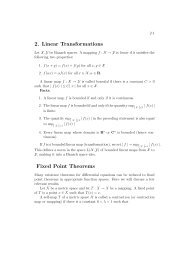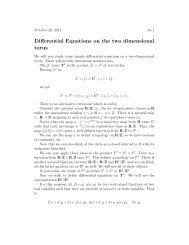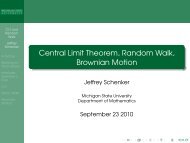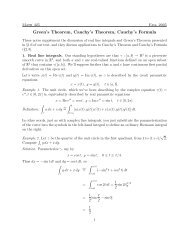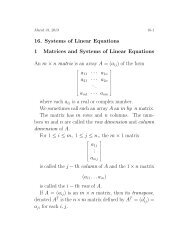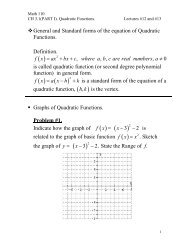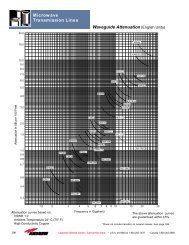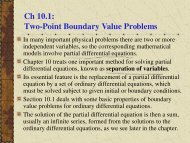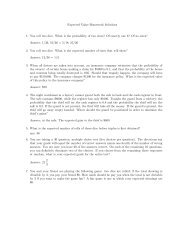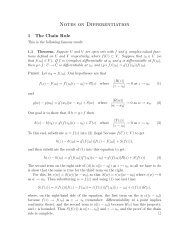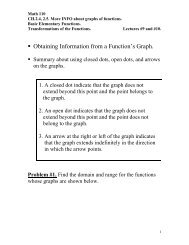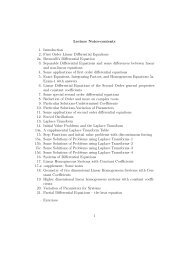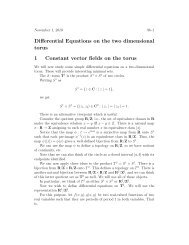12. Forced Oscillations
12. Forced Oscillations
12. Forced Oscillations
Create successful ePaper yourself
Turn your PDF publications into a flip-book with our unique Google optimized e-Paper software.
August 20, 2012 12-1<strong>12.</strong> <strong>Forced</strong> <strong>Oscillations</strong>We consider a mass-spring system in which there is an external oscillatingforce applied.One model for this is that the support of the top of the spring is oscillatingwith a certain frequency.The equation of motion becomesmü + γ ˙u + ku = F 0 cos(ωt). (1)Let us find the general solution using the complex function method.First assume that γ = 0; i.e., there is no friction.The given equation is the real part of the complex equation√ kmmü + ku = F 0 e iωt .Let ω 0 = be the natural frequency of the unforced equation. Ifω ≠ ω 0 , then the general complex solution isu(t) = c 1 cos(ω 0 t) + c 2 sin(ωt) + Re(m(iω) 2 + k eiωt )=F 0R cos(ω 0 t − δ) +k − mω 2 ) eiωt )=F 0R cos(ω 0 t − δ) +m( k − m ω2 ) cos(ωt)=F 0R cos(ω 0 t − δ) +m(ω 2 0 − ω 2 ) cos(ωt).Resonance:Note that if ω is close to ω 0 , then the magnitude of this is large. Thisthe phenomena of resonance. It is responsible for the breakdown of certainphysical processes.Note that if ω = ω 0 , then the amplitude of the particular solution becomesunbounded. In practice, one probably can’t get the frequency to be the same,but even if it is close the physical system in question will break down. Thiscan be observed in the playing certain high notes causing breaking of glass,the destruction of bridges in strong winds, etc.See the links for resonance on the class notes web page.F 0
August 20, 2012 12-2Beats: Again suppose the ω is close to ω 0 , γ = 0, and the motion beginswith u(0) = 0 and u ′ (0) = 0.Then, the constants c 1 , c 2 satisfySo, the solution isF 0c 1 = −m(ω 2 0 − ω 2 ) , c 2 = 0.F 0u(t) = −m(ω 2 0 − ω 2 ) cos(ω F 00t) +m(ω 2 0 − ω 2 ) cos(ωt)F 0=m(ω 2 0 − ω 2 ) (cos(ωt) − cos(ω 0t)) (2)which is the difference of two cosine functions with the same amplitudeand different frequencies. To get an idea of the graph of such a function, letus rewrite it.Recall the identitiescos(A + B) = cos(A) cos(B) − sin(A) sin(B),cos(A − B) = cos(A) cos(B) + sin(A) sin(B).Subtracting the first equation from the second givesLet us putor,so that (2) becomescos(A − B) − cos(A + B) = 2 sin(A) sin(B).A − B = ωt, A + B = ω 0 t,A = ω 0t + ωt2, B = ω 0t − ωt,2u(t) =F 0m(ω 2 0 − ω 2 ) (2 sin(ω 0t + ωt2) sin( ω 0t − ωt)).2
August 20, 2012 12-3If ω 0 − ω is small, then the function sin( ω 0t−ωt) oscillates much more2slowly than sin( ω 0t+ωt)). The graph of this product is illustrated in the2figures below. This gives rise to the phenomenon of “beats” in music whentwo vibrating strings have very close frequencies.Effect of Damping in <strong>Forced</strong> <strong>Oscillations</strong>:If we have a forced oscillation of the formmü + γ ˙u + ku = F 0 cos(ωt),with γ ≠ 0, thenthe general solution has one of the following forms:Case 1: γ 2 − 4km > 0whereu(t) = c 1 e r 1t + c 2 e r 2t + A cos(ωt) + B sin(ωt)r i = −γ ± √ γ 2 − 4km.2mAs t → ∞, the homogeneous part tends to zero. So, the solution approachesan oscillation with the same frequency as the external force. Thefunctionsc 1 e t 1t + c 2 e r 2t , A cos(ωt) + B sin(ωt)are called the transient and steady state motions of the system, respectively.Case 2: γ 2 − 4km < 0.Here, if ω 1 = √ 4km − γ 2 and a = γ , then the general solution has the2mformu(t) = e −at (c 1 cos(ω 1 t) + c 2 sin(ω 1 t))+A cos(ωt) + B sin(ωt)Again the first part tends to zero as t → ∞, and the solution tends toan oscillation with the same frequency as the external force. The first andsecond parts are again called the transient and steady state solutions.Some plots of solutions (see next page):
August 20, 2012 12-4
August 20, 2012 12-5


